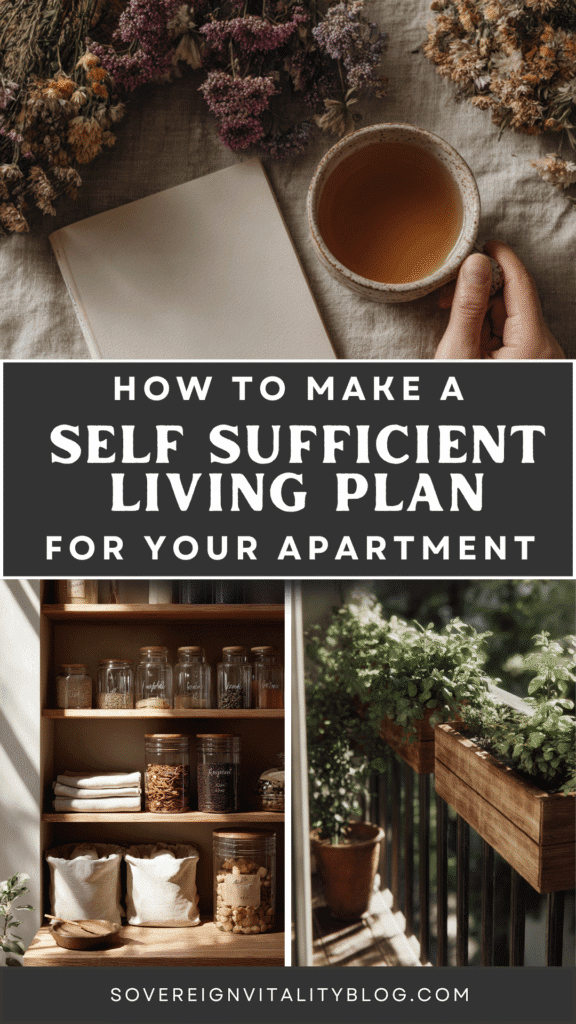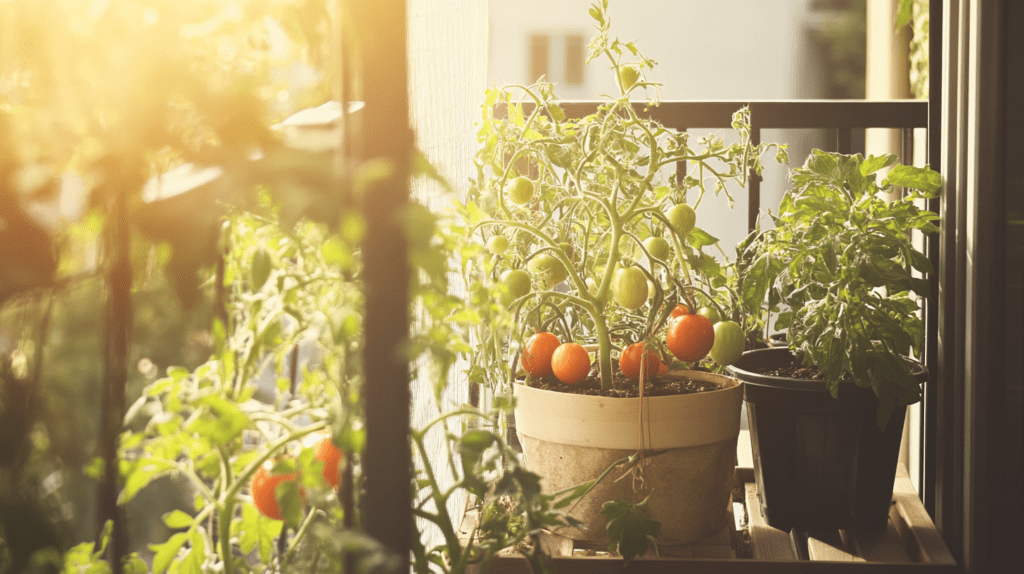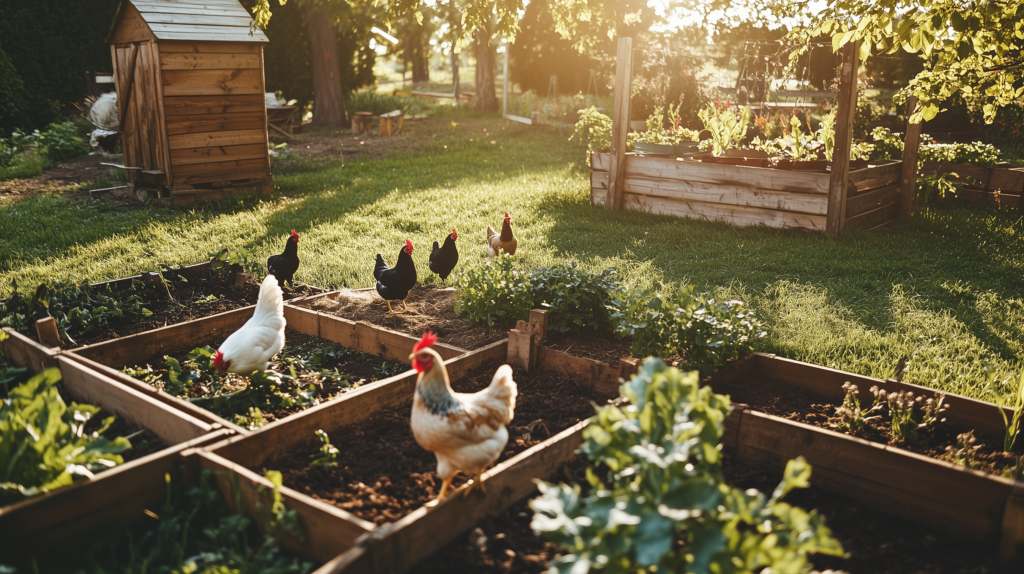This post may contain affiliate links, including those from Amazon Associates. If you make a purchase through these links, I may earn a commission at no additional cost to you. Learn more about our affiliate policy.
On a quiet evening last spring, I sat at my tiny kitchen table with a pen, a warm mug of nettle tea, and a deep desire to feel more rooted.
I didn’t have a garden or a stockpile of home-canned goods. But I did have a vision, and I began to map out what self-sufficiency could look like in my small apartment.
If you’re craving more sovereignty over your food, home, and rhythms but aren’t sure how to begin, this post is for you.

Creating your own self-sufficient living plan is less about immediate results and more about feeling grounded and clear in the choices you’re making every day.
Even in the limited space of an apartment, you can nurture your sense of autonomy. You don’t need sprawling fields or homestead-level resources to reclaim a sense of sovereignty. What you need is already within your reach.
Clarify What Self-Sufficiency Means to You

Before you plant a single seed or mix your first batch of homemade cleaner, it’s essential to clarify your vision.
Self-sufficiency isn’t a one-size-fits-all idea. It’s deeply personal.
For some, it’s food freedom, as in knowing exactly where your meals come from, down to the basil sprinkled on your pasta.
For others, it’s the empowerment of reducing toxins in your home or developing the confidence that comes from creating something yourself.
Take a moment to reflect and ask yourself:
- What does self-sufficiency look like in my life?
- What feeling am I ultimately seeking through these acts of self-reliance?
- Is it simplicity? Preparedness? Sustainability? Health?
Try this journal prompt: “When I imagine feeling more self-sufficient, what does my day look like?”
Perhaps you wake up and harvest vegetables from your container garden, infuse your morning tea with home-dried lavender, or spritz homemade cleaning spray across the counters, knowing you made it with care.
Your vision will become your guiding light, reminding you why you started when motivation wavers.
When I first reflected on this, I realized my vision was simplicity, resilience, and deep nourishment, both physical and emotional.
Clarifying this allowed me to let go of chasing aesthetic perfection I saw in Pinterest pins and instead embrace small, intentional acts each day.
Take Inventory of Your Space and Lifestyle

One of the most empowering parts of apartment homesteading is discovering that abundance can thrive even in the tiniest of corners.
Walk through your apartment slowly. Notice every nook and windowsill, balcony railing, under-sink cabinet, and empty closet corner.
Each of these spaces holds potential.
Make a simple list of all the usable areas in your home:
- Sunny windowsills for herbs and greens
- A balcony for a small vegetable container garden
- Cupboards or closets for storing bulk pantry goods
- Space under your sink or near your kitchen counter for a compost bin
- Empty shelves that could store homemade preserves or dried goods
Then, honestly consider your lifestyle rhythms.
How often do you cook meals at home?
Do you have freezer space for batch-cooked soups or homemade bread dough?
What’s the natural light like, bright and abundant, or softer and indirect?
These reflections will shape your plan realistically. Homesteading in an apartment is all about embracing constraints creatively, turning challenges into opportunities.
Set 1–2 Primary Goals to Focus On
With your vision clear and your space inventory taken, it’s time to set goals.
It’s tempting to dive in and tackle everything at once like growing food, preserving, DIY cleaning products and composting, but doing too much too quickly can lead to overwhelm.
Instead, choose one or two achievable goals to begin your journey. For example:
- Grow three types of herbs (perhaps basil, mint, and thyme)
- Replace two store-bought cleaning products with homemade versions
- Freeze or preserve food at least once each month
Start small and manageable. Achieving small goals will give you confidence and motivation to tackle more ambitious projects down the line.
When I started, my first two goals were to grow mint and basil and make my own all-purpose cleaner. These modest projects built my confidence more than I could have imagined.
Choose Beginner Projects That Align With Your Goals

Now, align beginner-friendly projects with your goals. Each project should bring you a step closer to the life you envisioned at the beginning.
If your goal involves growing your own food, consider:
- Starting an apartment balcony garden
- Growing sprouts or microgreens on your countertop
- Companion planting in containers to maximize space
If your focus is on sustainability, try:
- Making natural cleaning solutions with vinegar and citrus
- Crafting simple DIY body care products like deodorant or lotion bars
- Setting up a compost system beneath your kitchen sink
And if your vision centers around mindset and rhythms, try projects like:
- Establishing a gentle Sunday reset routine
- Creating a pantry-stocking or batch-cooking routine
- Learning one from-scratch cooking skill like baking bread or making broth
Choose projects that make your heart feel spacious and your hands eager to create. Need more inspiration? Explore my post: 7 Beginner Projects To Make Your Apartment More Self-Sufficient.
Make a Monthly Rhythm Plan
Now it’s time to bring structure to your vision and goals. Apartment homesteading fits beautifully within slow living principles. It’s rhythmic, seasonal, and intentionally paced.
Take your calendar or a blank notebook page and assign one small project or area of focus per month. Align these with the seasons or natural rhythms around you. For example:
- April: Start your herb garden or plant seeds indoors.
- May: Learn the basics of quick pickling vegetables or start composting.
- June: Begin freezing seasonal produce or dehydrating herbs.
- July: Experiment with DIY cleaning or personal care products.
Keep your plan simple and forgiving. Use a wall calendar, planner, or whiteboard to visually track your progress. This structure offers accountability without rigidity.
Track Your Progress and Celebrate Small Wins
This journey is more meaningful if you pause to recognize each small victory. Keep a notebook, Notes app, or even a simple list pinned to your fridge.
Each week, jot down what you accomplished, no matter how small it seems.
Maybe this week you harvested your first basil leaves or successfully made homemade broth from kitchen scraps.
These are genuine wins, worth celebrating. These small milestones affirm your growing sovereignty and capability.
When something doesn’t go according to plan, and inevitably, some things won’t, note what you learned from the experience.
Apartment homesteading is as much about cultivating self-compassion as it is about growing herbs or making jam.
Revisit and Adjust Every Season
Nature’s rhythms teach us that our needs shift with the seasons, and so too will your self-sufficient living plan.
Every few months, take a quiet evening like the one I described earlier, to sit with your journal and a cup of tea.
Reflect on what’s working, what feels like a struggle, and what you need more of right now. Ease, growth, nourishment, forgiveness?
Maybe winter calls you inward, toward preserving food and deepening kitchen skills. Spring might beckon you to expand your balcony garden or experiment with new DIY projects.
Allow your goals and projects to shift naturally. Remember, this plan is a framework, not a rigid set of rules. Trust your intuition. It’s always guiding you toward deeper alignment and ease.
Closing Encouragement
A self-sufficient life doesn’t happen all at once. It builds in windowsills, in mason jars, in the little rituals you reclaim from the noise of modern life.
Begin exactly where you are. One herb. One habit. One moment of sovereignty at a time.



